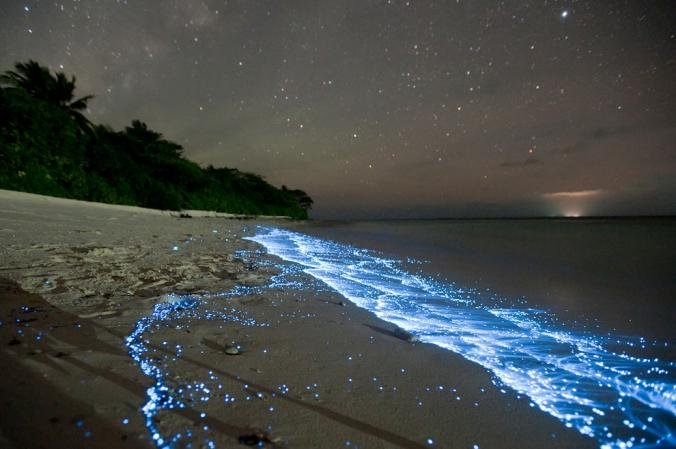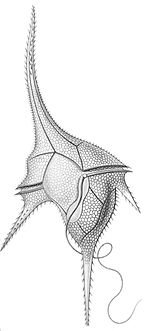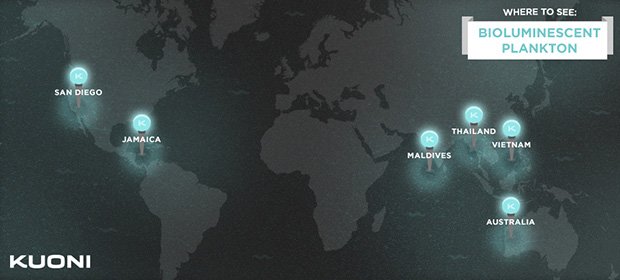
(Image source: nationalgeographic.com)
How would you feel if one night you were walking along the beach with your bare feet soaking in the warm dark water and all of a sudden hundreds of tiny blue sparkles started showing up around your wet toes? Somebody is walking on the stars...or maybe not. This phenomenon is called bioluminescence and is caused by a species of single-cell plankton, dinoflagellates.

(Image source: wikipedia.org)
How does it work?
Dinoflagellates use the mechanism of bioluminescence, which is widely spread in the natural world and especially among sea creatures. Bioluminescence is basically the production and emission of light by living creatures. It is caused by a chemical reaction triggered by 3 substances: Luciferin, Luciferase (don't be intimidated by the lucifer-word, there's nothing demonic going on here, natural miracles is still what we're talking about) and Oxygen [1]-[2]
What are these three?
- Luciferin : a protein-like substance that produces light (its name came from the latin word lux which means light)
- Luciferase : an enzyme found in certain living organisms (living organisms need enzymes to perform life-sustaining chemical reactions)
- Oxygen : a colorless and odorless gas of crucial importance for living creatures (it can be found not only in the air we breathe, but almost everywhere on the planet, just as well in water)
What triggers it?
When these three guys meet in the water, they need a little thrust to work together. Where does this thrust come from? Any movement in their surrounding environment. Let's see how that works[3]:
Every body carries an electrical charge, dinoflagellates have channels for protons to pass through their bodies. Protons are positively charged subatomic particles. When movement is spotted in the dinoflagellates' environment, those protons start moving around these channels, thus creating electrical pulses that trigger chemical reactions, which, in turn, activate luciferase. Luciferase works with her other two friends, luciferin and oxygen, to produce energy and guess what type of energy comes out after their bright collaboration...LIGHT! The funny thing about it is that it's called cold light because less than 20% of it generates heat.
This is a youtube video explaining how bioluminescence works:

Why do dinoflagellates use it for?
As phytoplankton, dinoflagellates have no other defence-mechanisms to protect themselves from predators[4]. That's why they use bioluminescence to stay safe. By emitting light they kind of warn their predators that they've seen them coming or just scare them and make them go away.
Of course, bioluminescence can be used for various other purposes in nature and these are:
- camouflage and hiding from predators
- self-defence
- attracting food
- communication
- attracting mates
When and where does it happen?
The phenomenon can be spotted only at night, as dinoflagellates' bioluminescence is controlled by a circadian clock. That means that there's an internalized alarm clock that strikes to synchronize specific organism functions with the day-night cycle. You do understand the need for that, it's not as effective to produce light to scare hunters off during daytime, but at night, a blue light coming out of nowhere can surely put some hungry sea creatures off.
People can witness this spectacular view (if they're lucky enough) in only a few places on Earth[5]. You can find sparkling plankton in San Diego and Jamaica, if you're in America. If you're in Asia you got more chances, as the Maldives, Thailand and Vietnam waters host bioluminescent plankton. There is also a possibility of finding dinoflagellates in Australia. Those places are shown in the map below.

(Image source: kuoni.co.ok)
What other animals use this mechanism?
Bioluminescence is widely used by different species on this planet. The mechanism is more or less the same, the reasons for using it vary as well among the species, but the effect in our eyes is always the same...AWE!
Maybe our friend @trumpman could get an inspiration for his next posts on strange animals and we get to see an article on "dazzling creatures" in the days to come.
You can also watch this video with general information about bioluminescence:

References
[1]wikipedia.org
[2]photobiology.info
[3]businessinsider.com-science
[4]wikipedia.org
[5]kuoni.co.uk
My fellow Steemians, thank you for reading today's post. You may have missed yesterday's post on Dirty Thunderstorms.
If you like my content you can follow me at @ruth-girl.
Please, also check the @steemstem project, a community-driven project meant to promote well-written, high-quality, STEM-related content (STEM as for Science, Technology, Engineering and Mathematics).
Lastly, for all interested in education, @steemiteducation is here to join all steemian educators in their common cause of making our job easier, more effective and more fun!
Until our next post,
Steem on, people, and keep smiling!
